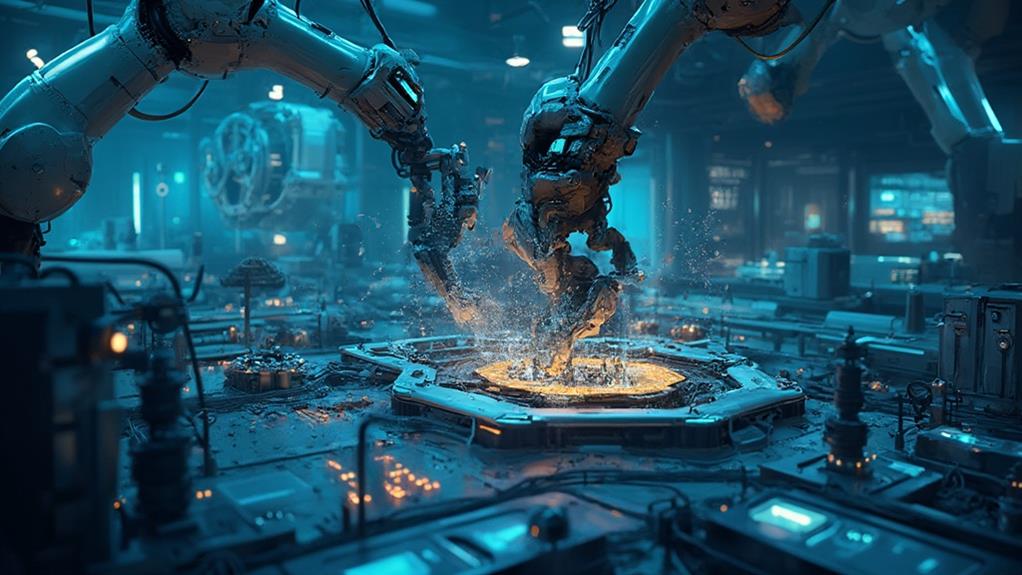Releasing the power of automation revolutionizes business operations by enhancing efficiency and accuracy. By implementing AI and RPA, companies can tackle both complex decision-making and repetitive tasks. This fusion allows AI to offer insights while RPA carries out routine operations, resulting in heightened productivity. Businesses benefit from reduced errors and operational costs, alongside increased adaptability to dynamic environments. Embracing automation technologies not only streamlines processes but also liberates human resources for strategic pursuits, ultimately fostering growth and competitiveness. Discover how automation shapes the future of business and optimizes your operational landscape.
Table of Contents
Key Takeaways
- Automation streamlines operations, freeing human resources from repetitive tasks.
- Integrating AI and RPA enhances productivity and operational efficiency.
- Embracing automation technologies boosts competitiveness and adaptability in dynamic markets.
- AI-driven automation improves decision-making by handling unstructured data effectively.
- Strategic deployment of automation technologies ensures sustainable growth and operational excellence.
Understanding AI and RPA

Diving into the domain of automation, it is essential to grasp the distinct roles of Artificial Intelligence (AI) and Robotic Process Automation (RPA) in transforming business operations.
AI applications excel in learning and problem-solving, mimicking human intelligence to adapt to new inputs and manage complex tasks. This empowers businesses to transcend traditional limitations, releasing unprecedented freedom in decision-making processes.
In contrast, RPA focuses on automating repetitive, rule-based tasks, simplifying operations and enhancing efficiency. While AI-driven automation can also increase productivity by automating repetitive tasks, RPA challenges persist, particularly in handling unstructured data and adapting to dynamic environments.
Understanding these technologies’ unique strengths and limitations allows organizations to strategically deploy them, optimizing processes while liberating human resources for more creative and strategic endeavors.
Achieving this balance is key to successful automation.
Exploring Automation Technologies
Automation, a catalyst for modern business transformation, brings forth a spectrum of technologies that redefine efficiency and innovation. As robotic advancements continue to evolve, they carve a path toward a future where automation trends dominate multiple facets of industry.
These technologies empower businesses by streamlining operations and freeing human resources from monotonous tasks, fostering a culture of creativity and strategic thinking. By embracing cutting-edge solutions, industries can transcend traditional boundaries, enhancing competitiveness and adaptability in a rapidly changing market.
With the integration of these advancements, companies not only achieve operational excellence but also release potential for growth and innovation. As automation trends progress, they provide a framework for enterprises to operate with unprecedented freedom and agility, shaping tomorrow’s business landscape.
Delving Into RPA Capabilities

As industries harness the transformative power of automation, the spotlight increasingly shifts toward Robotic Process Automation (RPA) as a pivotal tool in operational enhancement.
RPA benefits are profound, offering unparalleled efficiency by automating mundane tasks, thereby liberating human capital for innovative pursuits. This technology streamlines operations, reduces errors, and accelerates productivity across sectors.
Financial institutions, for instance, have realized considerable cost savings through strategic RPA implementation, reducing operational costs and improving accuracy.
However, RPA challenges must be acknowledged. The initial investment in implementation and the ongoing need for system updates can pose hurdles. Additionally, without proper management, RPA may lead to dependency on static processes, limiting adaptability.
Yet, for organizations seeking to maximize freedom and efficiency in their workflows, the strategic deployment of RPA provides a compelling pathway to sustainable growth and competitive advantage.
Comparing AI and RPA
Charting the landscape of automation, a critical analysis of AI and RPA reveals distinct yet complementary roles in enhancing business operations.
AI applications excel in learning and problem-solving, simulating human intelligence to tackle complex decision-making and handle unstructured data. Meanwhile, RPA focuses on automating repetitive, rule-based tasks, such as data entry, offering a straightforward approach to operational efficiency.
However, RPA limitations become apparent when dealing with tasks requiring adaptability or cognitive reasoning. As businesses seek freedom from mundane processes, understanding these differences empowers strategic deployment.
Integrating AI With RPA

In the domain of modern business, the integration of AI with RPA marks a pivotal evolution in automation technology. This fusion, known as AI Synergy within RPA Integration, supercharges business processes by marrying cognitive capabilities with task efficiency.
The results are transformative, offering businesses a new level of operational autonomy.
- Enhanced decision-making: AI provides insights, while RPA executes efficiently.
- Scalability: Businesses can expand operations without proportional cost increases.
- Error reduction: AI detects anomalies, ensuring high accuracy.
- Cost efficiency: Automation reduces reliance on manual labor, freeing resources.
- Continuous improvement: AI learns and adapts, optimizing RPA processes over time.
Frequently Asked Questions
What Industries Benefit Most From Implementing Ai-Driven RPA Solutions?
Industries experiencing significant advancements through AI-driven RPA include healthcare optimization, finance efficiency, and manufacturing productivity.
Retail management benefits from streamlined operations, while logistics sees enhanced efficiency.
Customer service and insurance processing are improved through automation, reducing errors and wait times.
In the supply chain sector, AI-driven RPA optimizes processes, ensuring timely deliveries.
These sectors achieve greater operational freedom and efficiency, transforming challenges into opportunities for innovation and growth through intelligent automation.
How Can Small Businesses Leverage Automation Without Significant Investment?
Small businesses can effectively leverage automation by adopting task prioritization strategies to identify high-impact, repetitive tasks suitable for automation.
Utilizing affordable automation tools like cloud-based software or open-source platforms can streamline operations without substantial investment.
By focusing on essential processes, businesses can enhance efficiency and productivity, freeing up resources for strategic growth.
This approach allows small enterprises to harness the benefits of automation, fostering flexibility and empowering them to compete effectively in a dynamic market.
What Are the Data Security Implications of Using AI and RPA?
The use of AI and RPA in automation raises significant data security implications, particularly concerning data privacy and compliance risks.
Automated breaches challenge data integrity, necessitating robust security frameworks. Effective risk management involves addressing ethical considerations and ensuring user consent.
Organizations must prioritize safeguarding sensitive information, balancing operational efficiency with the protection of individual rights, thereby fostering an environment that respects autonomy while embracing technological advancements.
How Does Ai-Driven RPA Impact Employment and Job Roles?
AI-driven RPA impacts employment by potentially causing job displacement, yet it simultaneously fosters skill enhancement and role evolution.
As repetitive tasks are automated, employees are freed to focus on strategic initiatives, prompting workforce adaptation. This shift encourages individuals to develop advanced skills, aligning with new technological demands.
Embracing AI-driven RPA allows businesses to harness innovation, improving operational efficiency while empowering employees to engage in more meaningful and fulfilling work.
What Are the Future Trends in AI and RPA Technology Development?
Future trends in AI and RPA technology development include the integration of predictive analytics and cognitive automation, enabling more intelligent workflows.
Machine learning advancements will drive these technologies to offer unprecedented adaptive capabilities, transforming operational efficiency.
As businesses increasingly seek innovative solutions, these trends will empower organizations to achieve greater flexibility and autonomy in their processes, ensuring sustainable growth and competitive advantage in an ever-evolving digital landscape.
Conclusion
The integration of AI and RPA is revolutionizing business operations by merging cognitive capabilities with process automation. This combination enhances task execution, facilitates intelligent decision-making, and improves data interpretation. As businesses invest in these technologies, understanding their distinct yet complementary strengths is essential for strategic deployment and maintaining a competitive edge. Embracing AI-driven RPA enables organizations to achieve unparalleled operational efficiency and effectiveness, positioning them at the forefront of innovation in the evolving automation landscape.






